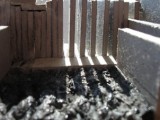Supervisors:
2010
The district of Evangelistria is a renown central area of Thessaloniki. It consists of a large number of apartment building units mixed within an area of various activities neither not well integrated within the surrounding urban fabric of the city. In fact, many of the activities are of a different character to the land uses of the urban network. The area (neighborhood) also incorporates places of collective "cultural memories" pointing out the long periods of its habitation. In spite of its fairly interesting character and sites, the area is still difficult to access or attract, thus forming an urban "enclave" within the urban network. The dominant elements of this place correspond to layers: "horizontal" (stops, old graves) and "vertical" (movement, Walls) and converse through the movement: In essense, I construct ways, while incorporating stops and passages and forming relationships:
Within the notions of stops, movement and passage, the main scope is to:
• attach new land uses in the area
• enhance the local aspects of the units
• make minimal interventions
• create a new local street network
• open minor passages
• define new 'meeting places'
My aim is firstly to change the character of the district of Evangelistria from a recreational place to a park of culture and "thinking" and, secondly, enhance the area's status by disclosing civic passages, connections and intercepting aspects. The idea for the area is to maintain its identity while 'keeping some of its urban secrets'. We promote planning without missing links and (without) erasing the previous character. The "spirit" of every small place is kept. There are various uses and settlements and some of them are "covered" or "wide open", well-lit or kept-in-the-dark, calm or noisy, deserted or crowded, linear or complex. The place of the old cemeteries were treated as cultural elements of the city. By this means, we show our respect to the city's history throughout the centuries. Some of the district's sites were chosen as main passage places through the old city's Walls. The main streets have vanished and new land uses are given to the existing buildings. Some of the old structures are demolished. As a result, we attain "free neighborhoods" and influence the relationship between built and non-built environment. Tree-lines and green ways are conserved and, by the same token, new tree-covered areas are planned.
